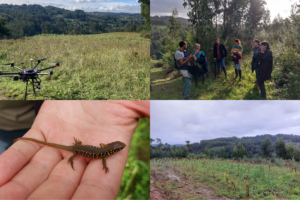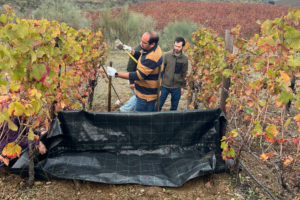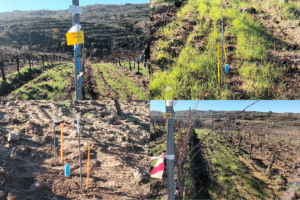The international project ECOSPHEREWINES held its second general assembly virtually last December. During the consortium meeting, significant progress in each of the project’s technical areas was presented.
ECOSPHEREWINES continues to follow its work plan, achieving progress in the field across the four experimental zones.
 In October, the pilot site in Betanzos was visited, where, thanks to the use of a drone, an updated aerial photo of the vineyard was obtained to facilitate the creation of a cartographic survey reflecting the vineyard’s current condition. Additionally, a new site inspection was carried out to exchange ideas for intervention. Historic areas of the Pagos de Brigante estate were visited, and part of the fauna coexisting in the vineyard was observed.
In October, the pilot site in Betanzos was visited, where, thanks to the use of a drone, an updated aerial photo of the vineyard was obtained to facilitate the creation of a cartographic survey reflecting the vineyard’s current condition. Additionally, a new site inspection was carried out to exchange ideas for intervention. Historic areas of the Pagos de Brigante estate were visited, and part of the fauna coexisting in the vineyard was observed.
At this Betanzos vineyard, the water outflow and existing pond, which are targeted for improvement under the project, were also examined. Planned activities include the removal of invasive species, cleaning, and restoration of the historic fountain that gives its name to the site – A Picha – and planting native species around the pond to enhance the ecosystem services of providing shelter and food for local fauna.
 In November, soil retention screens were installed in the experimental zone of Duorum to measure soil erosion at this experimental site, aiming to obtain comparative results between covered and tilled soils.
In November, soil retention screens were installed in the experimental zone of Duorum to measure soil erosion at this experimental site, aiming to obtain comparative results between covered and tilled soils.
At the French pilot site located in the V’Innopôle Sud-Ouest experimental area, the following ecosystem services have been identified for measurement or improvement: biodiversity, biological control, temperature regulation, and carbon storage. Activities planned include assessing the site’s biodiversity carrying capacity, planting floral cover to sustain natural predators of vine pests, and creating a temperature map to identify variations during risk periods (frosts and extreme heatwaves). Additionally, using all collected data, a carbon storage assessment will be conducted based on different soil maintenance methods and interactions with green infrastructure.
The first actions in Gaillac are scheduled for the first quarter of 2025.
 ECOSPHEREWINES also has an experimental plot in Arribes del Duero (Salamanca, Spain), where project activities have also begun. After collecting initial soil data, fine tillage was carried out, followed by fertilization with sheep manure pellets. Based on these activities, three different treatments have been established to measure the soil and plant response: one plot with planted vegetation cover, another with spontaneous cover, and a third with conventional tillage. Additionally, moisture sensors have been installed in each plot at three different depths.
ECOSPHEREWINES also has an experimental plot in Arribes del Duero (Salamanca, Spain), where project activities have also begun. After collecting initial soil data, fine tillage was carried out, followed by fertilization with sheep manure pellets. Based on these activities, three different treatments have been established to measure the soil and plant response: one plot with planted vegetation cover, another with spontaneous cover, and a third with conventional tillage. Additionally, moisture sensors have been installed in each plot at three different depths.


